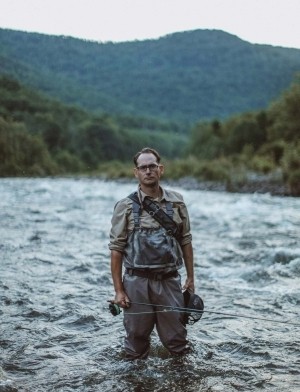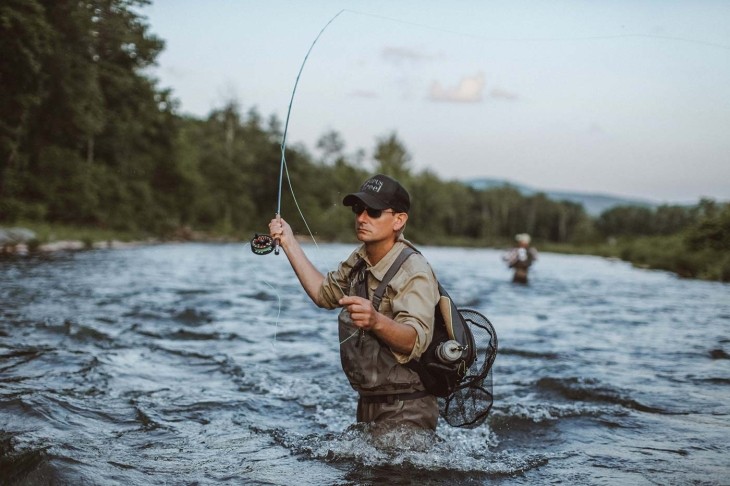
Todd Spire says he has been something of a fishing addict since he was a kid, but only relatively recently did he turn that passion into a way to make a living. After studying at various art schools, Todd started a marketing and graphic design firm in New York City in the 1990s. He left the city not long after 9/11 and landed in the Catskills several years later. Here, Todd learned the art of fly fishing, and in 2017 he founded Esopus Creel, a guiding service and retail shop in Phoenicia, New York. Despite a lifelong love of fishing and more than a dozen years spent prowling the waters of the Catskills, Todd finds more joy than ever in standing in a river with a flyrod in his hand and the mountains rising in the background.
I grew up fishing – not fly fishing. I came to that later, but I’ve been of a lifelong angler. Even though I grew up in the suburbs of northern New Jersey, I spent an enormous amount of time outside. I’m 47, so it was typical for my generation for our parents to tell us to go out and play, come back when it’s dinnertime. I used to spend my summers in central Vermont, where my grandfather lived. I was a Boy Scout for quite a while, so I would go to scouting camp, where I learned everything from orienteering to boating, fishing, outdoor skills. That was a big part of my summers.
I spent my college years in and out of various art schools in Boston, Manhattan, and back in New Jersey. I moved to New York City after school and started a graphic design and web development firm and kind of got into the whole digital boom that was happening in the late 1990s in New York City, and I was still there in 2001. I say all the time that New York City right after 9/11 was the most beautiful place on earth, but the rebound five or six months later was really bad. It was a very stressful time. I had a semi-successful design firm in SOHO, then the towers came down and the phone never rang again. Anything in the world of marketing was hit pretty heavily.
I always knew that I would end up in the mountains. I thought it would be Vermont, but I ended up here in the Catskills. The desire to get out of the city was fueled by a lot of things. I felt like it was time to follow my heart back up to the hills. I had lived in Manhattan twice over the course of my younger years, and I was done. I left the city in 2002, and I moved to the Catskills in 2008.
Growing up, I had a desire to keep fishing every chance I got, but I was never interested in bait fishing. I didn’t have the patience for bobber worm fishing, where you just toss it out there and wait. It had to be a lure and spinners. Something that kept me active. That’s why I love fly fishing. It’s active and requires so much concentration that it really drowns out everything else. It’s kind of like a meditation. It’s not just about the fish.
I began fly fishing when I moved to the Catskills. Becoming a guide was a natural evolution of being an angler and learning fly fishing and having mentors who were guides – and who needed help guiding. I’d get hired on larger trips, and I just really took to it, primarily to the instructing part of it. Being a good guide and being a good instructor are actually two different skill sets. Taking people who have never stepped foot in a river – and in some cases have never cast any type of rod, let alone a fly fishing rod – and teaching them about fly fishing. That’s really where my passion lies.
When you get somebody out in the middle of the river for the first time – seeing their body language change over the course of the four hours, seeing their demeanor change, seeing them relax and get really excited – that’s really special. It’s one thing to stand in a river in a bathing suit and go swimming. It’s another thing to be in the river in hip waders, and the way that the water kind of hugs your body when you’re in this waterproof outfit and you’re standing in the middle of the river with all these mountains surrounding you. Getting people to reconnect with nature is ultimately what it’s all about for my guests. Just offering them this really intimate opportunity to be out in nature, to get to stand in these hallowed waters and touch a wild trout and really have that experience.
The Catskills are known as the birthplace of American fly fishing. The sport started in the United Kingdom and was imported here, but it transformed dramatically in the mountains of the Catskills. The Catskills, and the lower Hudson Valley, is one of the first places where people ventured out into the mountains to recreate. Most of my clients are young professionals from New York City. When I get to teach a sports-oriented skill and combine it with various aspects of natural history and human history and outdoor recreation history and fly fishing history, it allows me to weave quite a tale.
I joke that I do a one-man show: it’s about four hours long, and I do it about 100 times a year. It’s a really, really interesting story. All of the rivers of the Catskills are impounded for New York City’s water supply. It’s the country’s largest all-natural water supply system. So there’s this very interesting symbiotic thing that happens: We give New York City our water, and then New York City comes back up north and spends their money here to maintain our local economies. There’s an interesting element there when you have somebody standing in the river, and they’re standing in their own water supply.
I get paid pretty well to guide, but I only get to guide five months a year. The season generally runs from April to October, but the good guiding doesn’t really start until the end of May. I still do some freelance marketing projects, but off season from fly fishing has been a little different from year to year for me. This year I’m doing grant writing for a community non-profit in Vermont. Last year I was a cider maker for a hard cider company here in the Catskills. The year before that I had more client work that was lingering. I own a retail shop that sells everything fly fishing. My online business has grown quite a bit over the years. I’m still pretty darned busy fulfilling orders through the holidays. It’s kind of a nice, nomadic winter.
I sit on the board of the local chapter of Trout Unlimited. Because the city owns all the water, we’re kind of like an advisory board. We keep state and city entities aware of things that we’re observing on the river from a habitat standpoint or a fisheries standpoint. It winds up being sort of advocacy work that we’re doing. We had a large power plant proposal that would have threatened not only homes, but a tremendous amount of wildlife. The whole community stood up against it, and last year we actually got the developer to withdraw their own proposal, which is extremely rare.
In 2020 New York state updated its Trout Stream Management Plan for how it’s managing and stocking rivers statewide. It was a 10-year-long project. When the draft proposal came out, our river was supposed to become the most heavily stocked trout river in the entire state, with 27,000 to 28,000 brown trout put into our river. Although the Esopus Creek has a huge number of wild fish, it has been stocked in the past. I helped launch a PR campaign, and there were an enormous number of public input comments. When the final proposal came out, the state had done a 180 and actually designated the Esopus a wild trout river, and we’re no longer receiving any stocked trout. Often, people expect that they pay their 20 dollars to 40 dollars a year, and the state is going to put fish into whatever body of water they like to fish, and then the fish come out when you throw your lures in there. It’s a God-given right as far as they’re concerned. So, the very idea of not stocking is terrifying for a lot of people.
We have this amazing opportunity to see what an incredible fishery will do when left to its own devices, without having fish thrown into it. The Catskills is a perfect place for trout to develop naturally. The existence of the impoundments for the sake of New York City’s water supply actually provides some immunity to global warming, because we have these great, deep underground aquifers that are releasing water through the rivers, and we have plenty of rain in our headwaters. The impoundments are actually the very thing that are creating the fisheries at this point and maintaining them. So it’s not something that would work in every river.
Interest in fly fishing has skyrocketed in the last seven or eight years, which is bringing a lot more people to the water. There’s some reticence to seeing more people on rivers in general. For somebody like me – I’m so impassioned about teaching and so impassioned about conservation – the audience that I’ve gained through my business is thirsting for that knowledge. With an increase of young anglers entering the sport, it’s also an increased opportunity and responsibility to educate them on all components of fishing, river ecology, river management.





